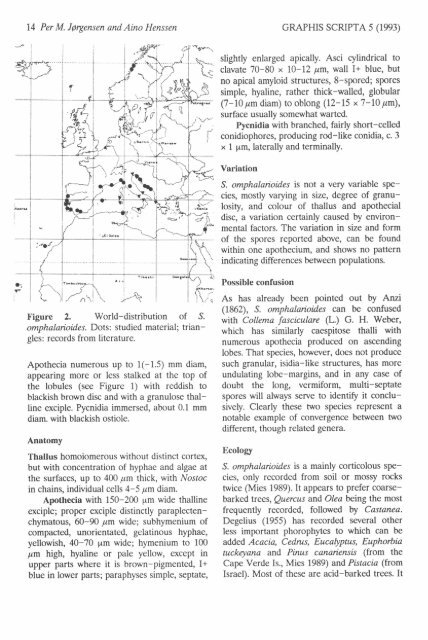CRAPHIS ScnIPTA - Universitetet i Oslo
CRAPHIS ScnIPTA - Universitetet i Oslo
CRAPHIS ScnIPTA - Universitetet i Oslo
Create successful ePaper yourself
Turn your PDF publications into a flip-book with our unique Google optimized e-Paper software.
1,4 Per M. Jpryensen and Aino Henssen GRAPHTS SCRTPTA s (1ee3)<br />
Figure 2. World-distribution of ,S.<br />
omphalaioides. Dots: studied material; triangles:<br />
records from literature.<br />
Apothecia numerous up to 1(-1.5) mm diam,<br />
appearing more or less stalked at the top of<br />
the lobules (see Figure 1) with reddish to<br />
blackish brown disc and with a granulose thalline<br />
exciple. Pycnidia immersed, about 0.1 mm<br />
diam. with blackish ostiole.<br />
Anatomy<br />
a'<br />
l"<br />
Thallus homoiomerous without distinct cortex,<br />
but with concentration of hyphae and algae at<br />
the surfaces, up to 400 pm thick, with Nostoc<br />
in chains, individual cells 4-5 pm diam.<br />
Apothecia with 150-200 pm wide thalline<br />
exciple; proper exciple distinctly paraplectenchymatous,<br />
60-90 pm wide; subhymenium of<br />
compacted, unorientated, gelatinous hyphae,<br />
yellowish, 40-70 pm wide; hymenium to 100<br />
pm high, hyaline or pale yellow, except in<br />
upper parts where it is brown-pigmented, I+<br />
blue in lower parts; paraphyses simple, septate,<br />
d<br />
t, r(<br />
t<br />
q\v/<br />
oXcair<br />
{.s<br />
to!<br />
-<br />
t<br />
c<br />
simple, hyaline, rather thick-walled, globular<br />
(7-10,am diam) to oblong (L2-15 x 7-I0 Fm),<br />
surface usually somewhat warted.<br />
Pycnidia with branched, fairly short-celled<br />
conidiophores, producing rod-like conidia, c. 3<br />
x L pm, laterally and terminally.<br />
Variation<br />
S. omphalarioides is not a very variable species,<br />
mostly varying in size, degree of granulosity,<br />
and colour of thallus and apothecial<br />
disc, a variation certainly caused by environmental<br />
factors. The variation in size and form<br />
of the spores reported above, can be found<br />
within one apothecium, and shows no pattern<br />
indicating differences benreen populations.<br />
Possible confusion<br />
As has already been pointed out by Aru:i<br />
(186?), S. omphalaioides can be confused<br />
with Collema fasciculare (L.) G. H. Weber,<br />
which has similarly caespitose thalli with<br />
numerous apothecia produced on ascending<br />
lobes. That species, however, does not produce<br />
such granular, isidia-like structures, has more<br />
undulating lobe-margins, and in any case of<br />
doubt the long, vermiform, multi-septate<br />
spores will always serve to identiff it conclusively.<br />
Clearly these two species represent a<br />
notable example of convergence between rpo<br />
different, though related genera.<br />
Ecology<br />
S. omphalaioides is a mainly corticolous species,<br />
only recorded from soil or mossy rocks<br />
twice (Mies 1989). It appears to prefer coarsebarked<br />
trees, Quercus and Olea being the most<br />
frequently recorded, followed by Castanea.<br />
Degelius (1955) has recorded several other<br />
less important phorophytes to which can be<br />
added Acacia, Cednts, Eucatyptus, Euphorbia<br />
tuckqana and Pinus canariensrs (from the<br />
Cape Verde Is., Mies 1989) and Pistacia (from<br />
Israel). Most of these are acid-barked trees. It

















